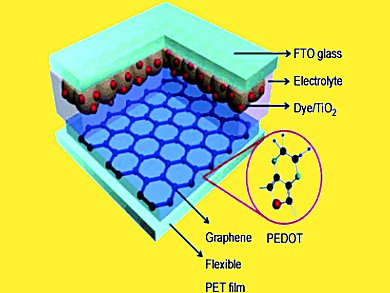Dye-sensitized solar cells (DSSCs) have emerged as a high-efficiency, low-cost alternative to solid-state silicon solar cells. Typically, DSSCs are composed of a mesoporous titania nanocrystal electrode on a transparent conductive oxide (TCO) substrate with ruthenium-based sensitizers on the titania nanocrystals, platinum on the TCO substrate as a counter electrode, and iodine/iodide electrolyte between the two TCO substrates. The high costs of these materials prevent the commercialization of DSSCs. Also finding a method to produce flexible DSSCs is an issue, because this would enable the fabrication of light-weight, thin, and low-cost DSSCs through roll-to-roll mass production.
Jong-Hyun Ahn and Jong Hyeok Park, Sungkyunkwan University, Suwon, Korea, coated a plastic substrate graphene with a conducting polymer (PEDOT), resulting in a flexible composite film. This film is used as counter electrode in dye-sensitized solar cells (DSSCs) instead of platinum/TCOs. The high conductivity of the graphene layer provides a further decrease of the surface resistance.
- Flexible and Platinum-Free Dye-Sensitized Solar Cells with Conducting-Polymer-Coated Graphene Counter Electrodes,
Kun Seok Lee, Youngbin Lee, Jun Young Lee, Jong-Hyun Ahn, Jong Hyeok Park,
ChemSusChem 2012, 5.
DOI: 10.1002/cssc.201100430




